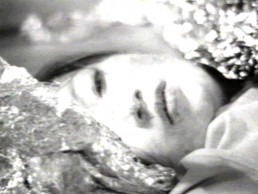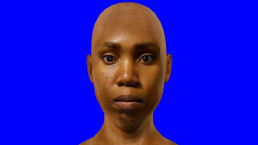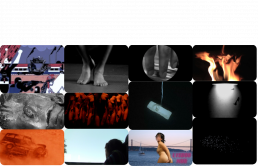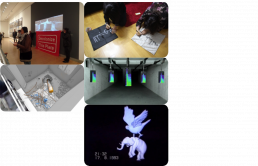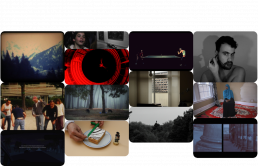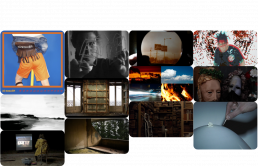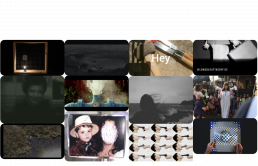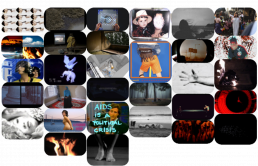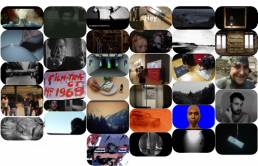“FUSO 2018 – 27 Agosto a 2 Setembro“
31 Agosto, 22h
Museu Nacional de Arte Antiga (MNAA)
Os Cinétracts de Maio de 68: A Revolução no Cinema
Curadoria de Bernardette Caille
Duração da sessão 50’
Os Cinétracts são curtas-metragens, deliberadamente anónimas, feitas durante as manifestações de maio de 1968 em Paris. Foram filmados sempre na forma de um trabalho coletivo sem assinatura, por vezes por diretores reconhecidos como Jean-Luc Godard ou Chris Marker. Os Cinétracts fazem parte dos projetos concebidos pelo programa Etats Généraux du Cinéma, reunidos a partir de 17 de maio de 1968. Cada Cinétract é filmado no banc-titre (suporte de animação) sem edição, com fotografias francesas e estrangeiras, geralmente numa única bobine de 16mm. Devem (de acordo com um texto da época) “desafiar-propor-chocar-informar-questionar-afirmar-convencer-pensar-gritar-rir-denunciar-cultivar”. A produção dessas curtas cessou nos meses seguintes ao final dos eventos de maio-junho de 1968.
Le Rouge tem um estatuto diferente. Intitulado Film-tract e numerado “1968”, é assinado pelo artista Gérard Fromanger, com Jean-Luc Godard como técnico. É um projeto de cartaz para o Atelier Populaire da École des Beaux Arts em Paris. Os cartazes com slogans políticos, todos anónimos e com a estética mais sóbria possível, eram ratificados por uma assembleia que votava todos os dias os cartazes que seriam divulgados no dia seguinte. O projeto de Fromanger e Godard não foi aceite. Atordoados por essa recusa, eles decidem fazer um filme. Fromanger, portanto, realiza o seu projeto em frente a uma câmara.
Durante as manifestações de maio de 1968 em Paris, estudantes e artistas juntavam-se para imprimir até 3000 cartazes por dia, que eram afixados por voluntários nas paredes de Paris e de outras grandes cidades francesas. Num trabalho coletivo, eles reuniam-se nos ateliers para debater sobre os slogans e o poder das palavras usadas, de forma a que as produções estivessem mais próximas da realidade das lutas. Essa “revolução plástica” também floresceu noutras áreas, como na música, no cinema, na filosofia e na literatura, que experimentaram imensas transformações, dando origem a movimentos originais e além-fronteiras.
Os Cinétracts foram feitos com a mesma filosofia: matéria-prima, sem edição, sem assinaturas, sem som. Estes filmes tiveram uma distribuição militante, notadamente através da cooperativa SLON – Service de Lancement des Œuvres Nouvelles (serviço de lançamento de novas obras) que, mais tarde se tornou Iskra (faísca em russo, em referência à Revolução de 1917).
Até ao momento, 111 Cinétracts foram recuperados e restaurados.
Cinétracts n° 01, 02, 04, 05, 06, 07, 08, 09, 12, 16, 21, 23, 24,26 e 106, fonds Iskra/
Iskra Collection
Gérard Fromanger & Jean-Luc Godard, Film Tract n.1968, 3’, mudo, 16mm, coleção de artista
31 Agosto, 23h15
Museu Nacional de Arte Antiga (MNAA)
“Sensação de Poder”: Corpos de Resistência
Curadoria de Lori Zippay
Duração da sessão 50’
Electronic Arts Intermix (EAI) é uma instituição sediada em Nova Iorque dedicada a promover a criação, exposição, distribuição e preservação de imagens em movimento. O arquivo da EAI é composto por mais de 3.800 obras de imagens em movimento, desde os anos 60 até à atualidade, desde obras de videoarte de referência de artistas pioneiros, a obras digitais de uma nova geração de artistas.
Este programa, concebido a partir do arquivo do EAI, apresenta quatro artistas – Anthony Ramos, Carolee Schneemann, Robert Beck e Sondra Perry – que empregam diversas tecnologias de imagem em movimento e estratégias conceptuais, para dar voz às noções de resistência cultural e ação política. Em obras que datam dos anos 60 até à atualidade, estes artistas usam dispositivos metafóricos, como performance direta e apropriação de mass media para responder às condições culturais urgentes da sua época. Em cada uma das obras, o corpo representa um meio carregado de significado para as suas investigações. Traçando um arco através de uma película de 16mm e vídeo analógico a preto e branco, através de uma câmara de vídeo de 8mm para software digital, estas obras também exprimem a evolução e o significado das tecnologias de imagens em movimento como ferramentas para os envolvimentos políticos dos artistas.
A história da videoarte está intrinsecamente ligada à história do videoativismo. No final dos anos 60 e início dos anos 70, o vídeo era considerado uma ferramenta de fazer arte potencialmente radical. Passível de reprodução e mutação, com a possibilidade de divulgação, o acesso democrático que estava em desacordo com a aura do objeto de arte único, o vídeo transportava a ideia de um paradigma “alternativo”, que articulava uma sensibilidade contracultural e, muitas vezes, transgressiva. Os primeiros coletivos de vídeo, assim como artistas individuais pioneiros, empregavam o equipamento portátil Sony Portapak ½” como arma para combater os media e cultura tradicionais.
Cerca de cinquenta anos mais tarde, uma nova geração de artistas desenvolve este legado na era digital, explorando o corpo e as suas representações – especialmente como refratado através da raça e do género – em relação às tecnologias digitais atuais e interfaces, de forma a refletir os seus significados culturais e políticos. Ao longo de cinco décadas e através de tecnologias em evolução, estes artistas traçam investigações ressonantes em poder expressivo dos media como ferramenta de resistência.
Anthony Ramos (EUA), Water Plastic Bag, 1973, 8’45’’
Water Plastic Bag é uma série de performances de duração, arriscadas, que Ramos criou com artistas como Lowell Darling e Joe Ray. Nesta performance inquietante, com ecos autobiográficos da resistência na era da guerra do Vietname, Ramos e Darling estão ligados através de sacos de plástico do tamanho de corpos e enterrados na areia numa praia. À medida que as pessoas passam pela zona costeira, os homens lutam para se libertarem da areia, tombando revestidos com os seus sacos de plástico, em direção ao mar. Eventualmente, emergem das ondas e libertam-se dos sacos.
Carolee Schneemann (EUA), Snows, 1967/2009, 20’30’’
Esta versão recentemente recuperada da documentação do grupo de performances Snows, de 1967, criada a partir da indignação de Schneemann em relação às atrocidades da guerra do Vietname. Um ambiente etéreo que combina painéis de iluminação coloridos, projeção de filmes, colagem dividida, sacos pendurados com água colorida, “neve”, ramos quebrados, corda, alumínio e espuma para criar o cenário no qual um sistema de interruptores eletrónicos ativados pelo público controlam os elementos da performance/instalação. Imagens do filme, diapositivos e técnicas de live action, performers fantasmagóricos nesta performance teatral cinética inovadora.
Câmara Alphons Shilling
Fotografia Herbert Migdoll
Performance Shigeko Kubota, Tyrone Mitchell, Phoebe Neville, Carolee Schneemann, James Tenney, Peter Watt
Sistema de projeção de meios eletrónicos Carolee Schneemann (Colaboração com Experiments in Art and Technology)
Produção de coreografia – filme Viet-Flakes por Carolee Schneemann
Som original James Tenney (1965), reeditado em 2008
Apresentado por Paul Libin no Martinique Theatre, Nova Iorque, Anfry Arts Week, 1967
Edição Carolee Schneemann e Trevor Shimizu, Electronic Artes Intermix, 2008
Robert Beck (USA), The Feeling of Power, 1990, 9’
Criado no auge da crise da SIDA nos Estados Unidos, The Feeling of Power é um manifesto autorreflexivo que radica no vídeo ativismo que transformou o movimento de “televisão guerrilha” dos anos 70, na era das câmaras de vídeo de 8mm. Beck começa por transportar o espectador através de um divertido vídeo que liga a televisão americana, os subúrbios pós-guerra, a cultura pop e o consumismo e, posteriormente, de uma forma assustadora e premonitória, documenta uma manifestação organizada pelo coletivo ativista pela SIDA, ACT UP na Trump Tower em Nova Iorque.
Sondra Perry (EUA), Graft and Ash for a Three-Monitor Workstation, 2016, 9’
Em Graft and Ash for a Three-Monitor Worksation, Perry surge como um avatar que separa a alma do corpo, numa performance que proporciona uma poderosa investigação da representação de corpos negros no domínio da tecnologia contemporânea, software e interfaces digitais. Perry traz para primeiro plano as ferramentas da produção digital para refletir criticamente sobre elas e recolocar estas novas tecnologias de representação. “Não temos modo de segurança.”
“FUSO 2018 – August 27 to September 2“
August 31, 10pm
Museu Nacional de Arte Antiga (MNAA)
The Cinétracts of May 68: The Revolution in Cinema
Curatorship by Bernardette Caille
Total running time 50’
The Cinétracts are deliberately anonymous shorts, shot during the May of 1968 protests in Paris. They were always filmed collectively, unsigned, and sometimes by well-known directors such as Jean-Luc Godard or Chris Marker. The Cinétracts are a part of the projects conceived by the program Etats Généraux du Cinéma, assembled after May 17, 1968. Each Cinétract is filmed in the banc-titre (animation stand) with no editing, using French and foreign photographs, generally on a single 16mm reel. They must (according to a text from that time) “challenge-propose-shock-inform-question-affirm-convince-think-scream-laugh-denounce-cultivate”. These shorts stopped being made in the months following the end of the events of May-June 1968.
Le Rouge has a different status. Titled Film-tract and numbered “1968”, it is signed by the artist Gérard Fromanger, with Jean-Luc Godard as the technician. It sprung from a poster project for Atelier Populaire of the École des Beaux Arts in Paris. The posters, containing political slogans, all anonymous and with as sober an aesthetic as possible, were ratified by an assembly that voted every day on which posters would be revealed the following day. Fromanger and Godard’s project was not accepted. Stunned by this rejection, they decided to make a film and, therefore, Fromanger, directs his project in front of the camera.
During the May 1968 protests in Paris, students and artists came together to print up to 3000 posters per day, which were then affixed by volunteers on the walls of Paris and other large French cities. For a collaborative project, they would meet in ateliers to debate the slogans and the power of the words used, so that the results would be closer to reality and to the struggles. This “plastic revolution” also flourished in other areas, such as in music, cinema, philosophy and literature, which experimented with immense transformations, laying the foundations for original and boundary-breaking movements.
The Cinétracts were made according to the same philosophy: raw material, no editing, unsigned, silent. These films had a militant distribution, notably through the SLON Cooperative – Service de Lancement des Œuvres Nouvelles (department for the launching of new works) which later became Iskra (spark in Russian, referring to the 1917 Revolution). To date, 111 Cinétracts have been found and restored.
Cinétracts n° 01, 02, 04, 05, 06, 07, 08, 09, 12, 16, 21, 23, 24,26 and 106, fonds Iskra/Iskra Collection
Gérard Fromanger & Jean-Luc Godard, Film Tract n.1968, 3’, no sound, 16mm, from the artist’s collection
August 31, 11:15pm
Museu Nacional de Arte Antiga (MNAA)
“The Feeling of Power”: Bodies of Resistance
Curatorship by Lori Zippay
Total running time 50’
Electronic Arts Intermix (EAI) is a New York-based resource dedicated to fostering the creation, exhibition, distribution and preservation of moving image art. EAI’s archive of over 3,800 moving image artworks spans the 1960s to the present, from seminal video art works by pioneering figures to digital works by new generations of artists.
This program, drawn from EAI’s archive, features four artists – Anthony Ramos, Carolee Schneemann, Robert Beck, and Sondra Perry – who deploy diverse moving image technologies and conceptual strategies to give voice to notions of cultural resistance and political action. In works that date from the 1960s to the present, these artists employ metaphoric devices such as direct performance and mass media appropriation to respond to the urgent cultural conditions and events of their time. In each of these works, the body represents a charged site for their investigations. Tracing an arc from 16mm film and black-and-white analogue video, through the 8mm camcorder to digital software, these works also speak to the evolution and meaning of moving image technologies as tools for artists’ political engagements.
The history of video art is inextricably linked with the history of video activism. In the late 1960s and early 1970s, video was seen as a potentially radical art-making tool. Reproducible and mutable, with the possibility of widespread, democratic access that was at odds with the aura of the unique art object, early video carried with it the idea of an “alternative” paradigm that articulated a countercultural, often transgressive sensibility. Early video collectives, as well as pioneering individual artists, deployed the portable ½” Sony Portapak equipment as a weapon with which to “talk back” to the mainstream media and culture.
Almost fifty years later, a new generation of artists is advancing this legacy in the digital era, exploring the body and its representations – particularly as refracted through race and gender – in relation to current digital technologies and interfaces to reflect on their cultural and political meanings. Across five decades and through evolving technologies, these artists chart resonant investigations into the expressive power of media as a tool for resistance.
Anthony Ramos (USA), Water Plastic Bag, 1973, 8’45’’
Water Plastic Bag is one of a series of durational, risk-taking performances that Ramos made with fellow artists Lowell Darling and Joe Ray. In this unnerving performance, which has autobiographical echoes of Vietnam War-era resistance, Ramos and Darling are tied into body-sized plastic bags and buried in sand on a beach. As passers-by stroll along the shore, the men struggle free of the sand and then tumble, sheathed in their plastic bags, into the surf. Eventually they emerge from the waves and free themselves from the bags.
Carolee Schneemann (USA), Snows, 1967/2009, 20’30’’
This is a newly restored version of documentation of the 1967 group performance Snows, which was built out of Schneemann’s outrage over the atrocities of the Vietnam War. An ethereal stage environment combining coloured light panels, film projection, torn collage, hanging sacks of coloured water, “snow,” crusted branches, rope, foil and foam was the set and setting in which an audience-activated electronic switching system-controlled elements of the performance/installation. Images from film, slide and live action propel silent, ghostly performers in this breakthrough mixed-media kinetic theatre performance.
Camera Alphons Shilling
Fotographs Herbert Migdoll
Performance Shigeko Kubota, Tyrone Mitchell, Phoebe Neville, Carolee Schneemann, James Tenney, Peter Watt
Electronic media system projection environment Carolee Schneemann (Collaboration with Experiments in Art and Technology)
Choreography production – film Viet-Flakes by Carolee Schneemann
Original sound James Tenney (1965), re-edited in 2008
Presented by Paul Libin at the Martinique Theatre, New York, Anfry Arts Week, 1967
Editing Carolee Schneemann and Trevor Shimizu, Electronic Artes Intermix, 2008
Robert Beck (USA), The Feeling of Power, 1990, 9’
Created during the height of the AIDS crisis in the U.S., The Feeling of Power offers a self-reflexive manifesto on grassroots video activism that brings the 1970s “guerrilla television” movement into the age of the 8mm video camcorder. Beck first takes the viewer on a spirited video romp that links American television, post-war suburbia, pop culture, and consumerism, then chillingly and presciently documents a 1989 protest by the AIDS activist collective ACT UP at Trump Tower in New York.
Video Robert Beck
Music Stephen Vitiello and Shin Shimokawa
Text Peter Bowen and Robert Beck
Studio, Editing and Post-production Electronic Arts Intermix
This project was created with 8mm video equipment and was made possible in part with the support of Made in 8, sponsored by The Kitchen Center for Music, Dance, Performance and Film
Sondra Perry (USA), Graft and Ash for a Three-Monitor Workstation, 2016, 9’
In Graft and Ash for a Three-Monitor Workstation, Perry appears as a disembodied avatar, in a performance that offers a powerful investigation of the representation of black bodies in the realms of contemporary technology, software, and digital interfaces. Perry foregrounds the tools of digital production to critically reflect on and redeploy these new technologies of representation: “We have no safe mode.”



